Photos from Sarao Motors Inc.
Each day, we never fail to notice the congestion on the streets, or the barkers on the road trying to call your attention with their loud monotonous cries. Top everything with traffic enforcers and their exaggerated signaling and you could say that yes, there might be only one experience that amalgamates all of the road’s dusty, coughing character: that is, in the abode of the old king of the road, that which has swerved and ruled every avenue possible.
The road is inside the jeepney.

1950’s painting of a Sarao Jeep.
You might have outgrown the thrill of riding the jeep (or at least its steadily increasing fare). It seems that this very staple idea of our mass transportation is taken for granted; really, have you ever tried to ask where it came from and how it was made?
For instance, did you know that ‘jeeps’ became ‘jeepneys’ because jeeps then were perceived as a ‘poor man’s car’, where people would usually bump knees during the rocky ride? The portmanteau of ‘jeep’ and ‘knee’, surprisingly enough, became the origin of this term.
To support this unexamined factor of production in our economy, The LaSallian gives you a sneak peek of the operations of one of the most influential jeepney companies in the Philippines, Sarao Motors Inc.
Sarao Motors Inc. is a jeepney manufacturing company that started after World War II. The Saraos were one of the innovators of new public transportation vehicles, using old military-type jeeps left by the Americans. Vice President for Productions and Architect Ed Sarao explains that the Sarao family comes from a line a horse carriage drivers, or kutsero, making them familiar with main transport routes and thus equipped for the management of a transport manufacturing company, less horses of course.

Before its synonymous association to jeepneys, the Sarao name was more often associated to cocheros de calesa or horse carriage drivers back in Spanish times.
Planning the ride
But how exactly are jeepneys made? (And nope, this is not like your typical car construction, the manufacturing of a thing that might be scoffed at for failing to activate second gear quickly, without a top and back load, but nonetheless still capable of climbing mountains. These are jeepneys we’re talking about.)
Jeepney creation usually takes a quarter of a month at the most optimal conditions. Because of unforeseen events, such as heavy storms, Sarao adjusts the process duration to 60 up to 90 working days. The process of making a jeep involves five key steps: making the frame, shaping the body, smoothening, mounting, and designing.
The frame making part of jeepneys requires both delicate machinery and dedicated labor. The main frame is made of black iron, and is first melded by a craftsman who then strengthens the frame with a hydraulic press.
Sarao explains, “So yung mga components dito ginagawa. Yung mga components ng chassis, pira-piraso yan. Binunuo nila into subassembly bago they go into body and detail. Eto yung skeleton, dito kinakabit yung engines, yung tires [It is during this stage that the components are made; the components of the chassis, for instance, are made piece by piece. These are processed for subassembly before they are integrated into the body and detail. There is also the skeleton, where the engines and tires are eventually attached.]”
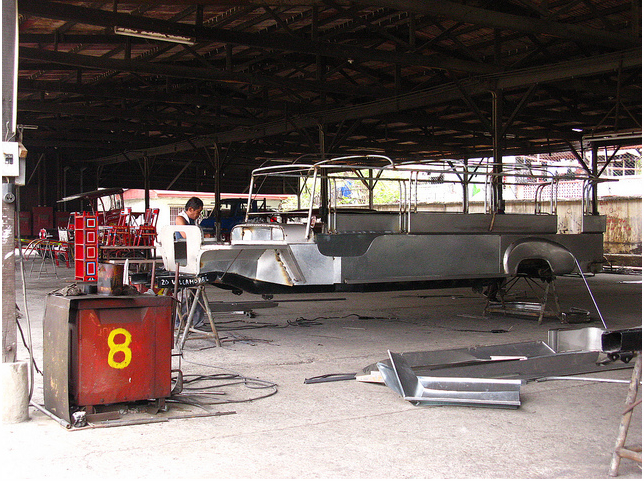
Hewing the jeep body.
Then there is the body shaping, is where the jeepneys dimensions are defined. “The 20-22 passenger seat jeepney is the most popular, pero dati 16-18,” explains Sarao when asked about shorter jeepneys back in the 1950s. “Ngayon mas in demand yung mahaba, that’s why we produced this [model].”
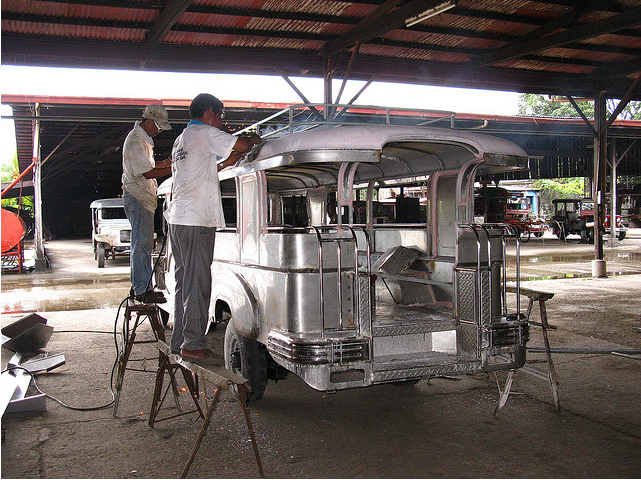
An unpainted Sarao jeep.
The jeepneys’ bodies follow a padron or color pattern which the craftsmen follow. “The darker (padron) are older, while the lighter patterns are newer. All of those designs, nagagamit namin. For example, a balikbayan wants to have a more classic retro style jeep; we keep [the old padron] all for reference. Kasi meron din kaming customers from the provinces, they like the more traditional designs.”
One can also classify the regional origin of a Sarao jeep from its body. “There is a distinction [in the design] of jeep per region. Sa Rizal, Antipolo, and that side, colorful pero massive yung sasakyan. Down south, makikita mo the traditional type. Up north, sa mga places tulad ng Baguio and Benguet, ‘yun yung mga jeep na for carrying very heavy loads and steep places tulad ng Sagada. Yung tipong kahit sa bubong pwede pa sumakay [The type that can carry people on the roof].”
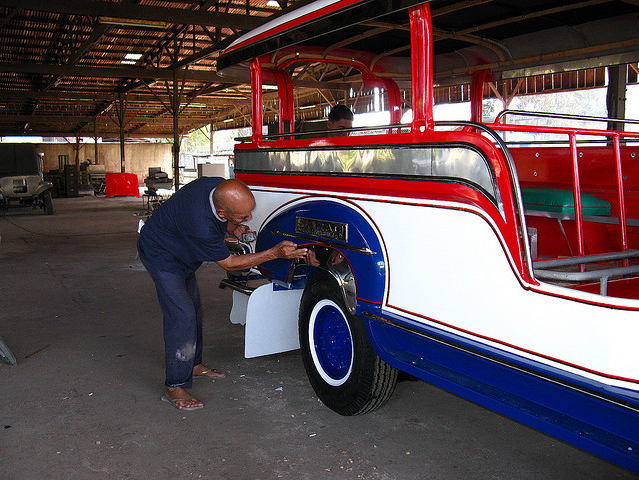
Painting and smoothing happens before the engine can be mounted.
After the body and the frame are finished and attached well to each other, the smoothing process begins. This is where Sarao’s signature silhouette comes in. Sarao explains that with a trained eye, one can distinguish a Sarao jeep from afar. The smoothening of the jeep uses putty to smooth the screws while removing some of the unwanted details to improve the jeepney’s overall aesthetic.
Mounting takes place after smoothing. The engines used in jeepneys are stock motors from countries like Japan. The jeepney makers clean, check, and tune these to ensure peak performance before mounting them on the jeeps. The release of bigger and more powerful engines necessitate the strengthening of the frame and the body. The mounting process also includes attaching the battery and other necessary accessories like the side mirror.
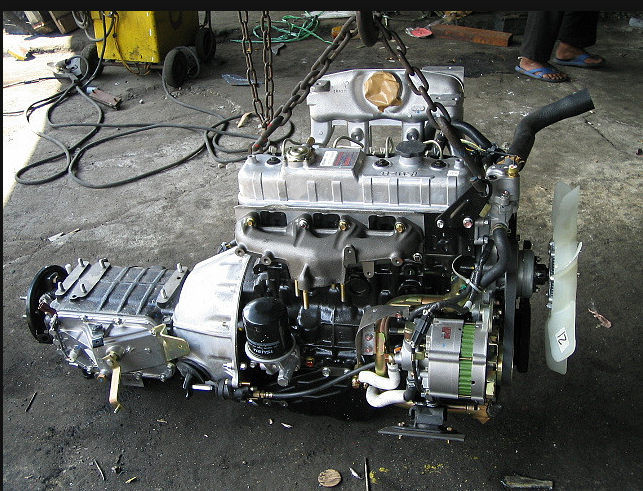
A jeepney engine. This is installed after smoothing the jeepney body.
Design is the last part of jeepney construction. It is said that no two jeepneys are alike. “Every jeep has its own personality, or identity,” affirms Sarao. “Yung pinaka standard nila is yung haba, pero yung design kanya-kanyang diskarte ng mga customer yan. Parang tailor-made suit. One can alter the buttons or the color. [The only thing common to all in terms of design is the standard length, but each customer has his or her own way of going about the jeepney’s design. Much like a tailor-made suit.]”
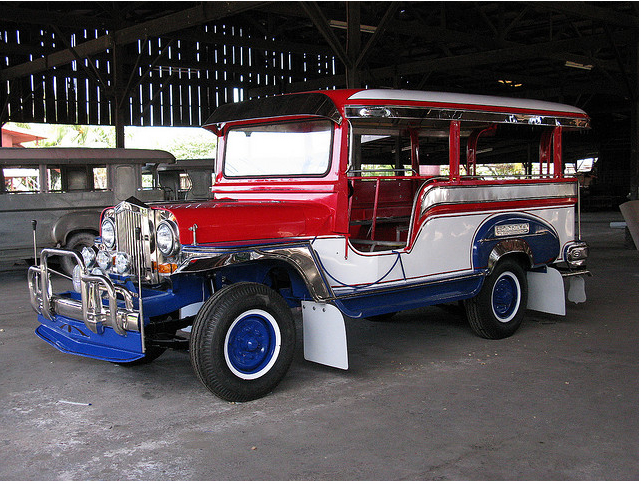
A finished tricolor jeepney, a little too late for Les Miserables.
In this age of change we cannot help but brace waves of new advancements in mass transport. Air conditioned jeepneys, for example, are being designed and make their routes on certain roads, and some organizations are developing electronic jeepneys that may appear sooner or later in front of our very own University.
Conversely, certain roads have banned the presence of public utility jeepneys for reasons of pollution or noise control. There are even speculations of lobbyist groups having jeepneys totally phased out due to congestion issues, threatening the entire jeepney industry and the people who are part of it, from the fabricators to the metal craftsmen to the drivers. Can they be considered as part of a vanishing trade?
Despite all this, jeepney companies like Sarao Motors Inc. have positioned themselves over the years, firmly upholding jeepney quality, providing an economic staple and necessary service: a part of life where we could still place hope in a brighter future for a distinct part of culture, innovating the jeepney rather than just letting the old king of the road go down in dust and shambles.
